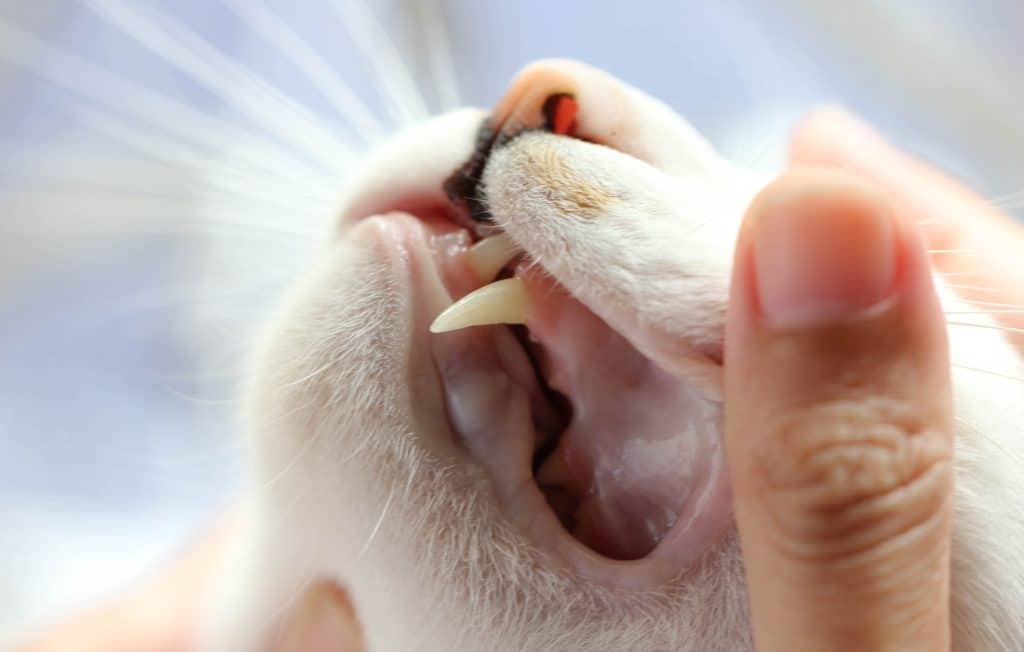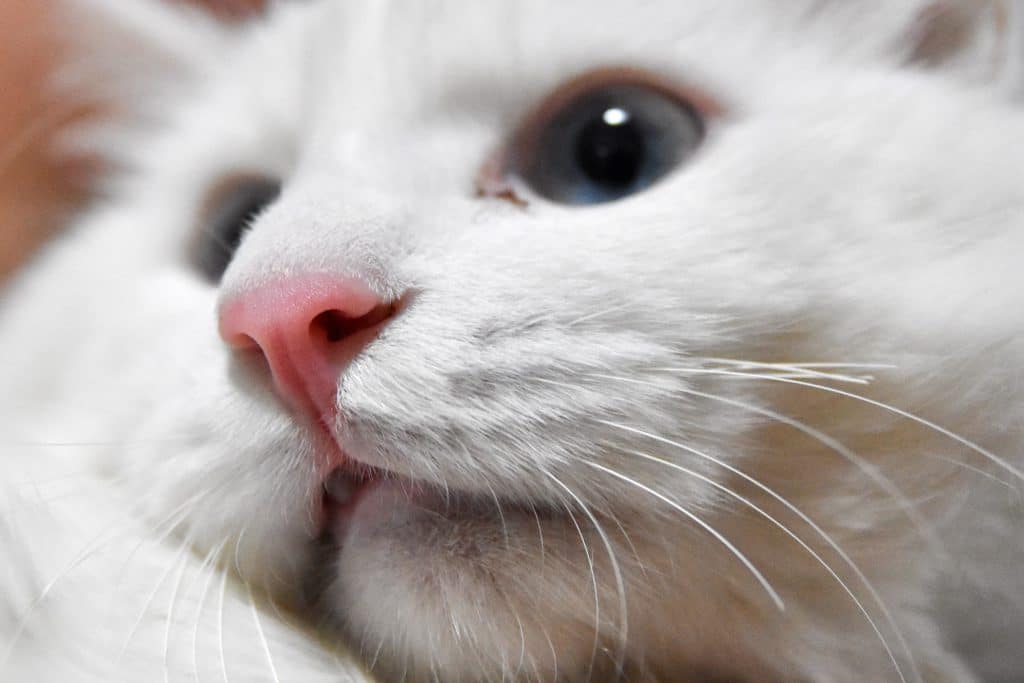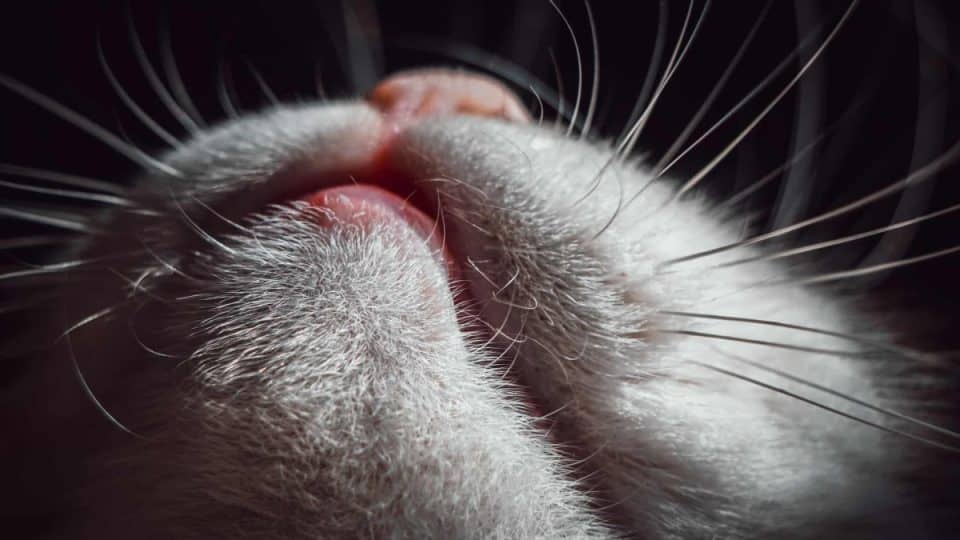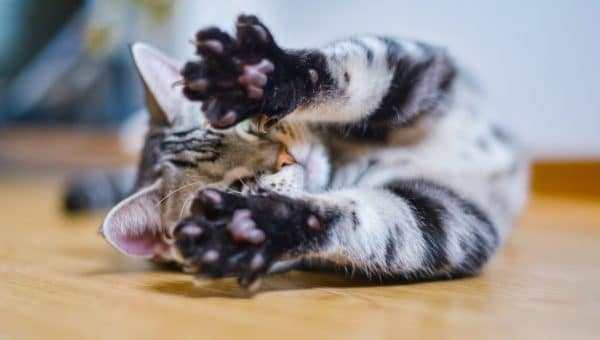- Not a substitute for professional veterinary help.
Say you’re taking a picture of your cat and notice their bottom lip is red and swollen. You may start to worry about your cat’s health and whether the swelling is severe. “Lip swelling can be due to a wide spectrum of conditions, from mild irritation to a serious cancerous process, and several conditions in between these two extremes,” says Zac Pilossoph, DVM, consulting veterinarian at Healthy Paws Pet Insurance.
Typically your cat’s lip will stop swelling once they get treatment. Luckily, a vet can help you uncover the root cause of your cat’s swollen lip and the best way to fix it. Below, we’ll break down all the causes of a cat’s swollen lip, how vets diagnose the condition, and what recovery looks like for your kitty.
What Does Swollen Cat Lip Look Like?
A swollen lip can range from pale pink or harsh red. Additionally, it may look puffy like your cat is trying to pout, or curled as if their lip is curving outwards.
Pilossoph says sometimes redness and swelling are the only issues you see. Other times, your cat may show additional symptoms. For example, depending on the condition, you might spot a lump, sore, or scab on your cat’s lip. They may also exhibit unusual behaviors, such as refusing food or scratching their itchy mouth with a paw.
7 Causes of a Cat’s Swollen Lip
Different conditions can cause your cat’s bottom lip to swell. Generally, the more common causes tend to be mild and easily treatable. That said, sometimes swelling can signal a rare or severe health issue. Some possible reasons behind your cat’s fat lip include the following.
- Cat acne: Like humans, cats can get acne on their lips and chin when dirt or bacteria enter their pores. You may see black dots or pus-filled lumps. If your cat scratches itchy acne, they may rip off the pustule, which scabs over and swells.
- Eosinophilic granuloma complex (EGC): EGCs are allergic reactions to triggers such as flea bites, mold, and certain foods. Lip EGCs often appear as pink or yellow nodules.
- Skin parasites: The mite Demodex murilegi can burrow into your cat’s skin around their lips and nose. Your cat may develop crusty ulcers or hair loss (alopecia) near the mites’ hiding spot.
- Dental disease: Pilossoph says it is rare for dental disease to cause lip swelling directly. But if your cat has missing or broken teeth, their lips can get trapped in the gap, creating ulcers in your cat’s lip.
- Electrical burns: Chewing on electrical cords is the most common way cats burn their lips. Even mild burns can cause pain, and you may notice your cat avoiding food and refusing to let you touch their face. However, intense burns can lead to severe swelling and sores that require prompt medical attention.
- Pemphigus vulgaris: Pemphigus vulgaris is an extremely rare autoimmune disease that attacks mucus membranes. Your cat’s lip develops blisters that quickly pop, leaving painful ulcers and mouth sores behind. You may also find ulcers on their anus and genital openings.
- Tumors: Cats can develop a hard, irregularly-shaped tumor on their lip that oozes fluid. If cancer spreads to your cat’s mouth and throat, your cat may develop bad breath, a poor appetite, excess drooling, and a silent meow.

iStock/zygotehasnobrain
When to See a Vet About Your Cat’s Swollen Lip
Lip swelling usually resolves after treatment. First, however, you need to know what causes the swelling to give your cat relief.
Pilossoph explains that any time your cat’s bottom lip is swollen for more than 1-2 days, it should be evaluated by a veterinarian. Timely treatment can turn a potentially life-threatening issue into a manageable one. Even if your cat’s swollen lip seems harmless, ruling out the more severe conditions can give you peace of mind.
How Your Vet Diagnoses & Treats Each Cause of Lip Swelling
Each condition causing a swollen lip has its own treatments, so an accurate and prompt diagnosis is essential to give your cat the most effective relief. Most diagnostic tests require a sample of the skin cells to examine under a microscope. A skin cytology or skin scraping collects cells from the lip’s surface, while a biopsy removes part of the lip.
1. Cat acne
- Diagnostic tests: Skin cytology or skin scraping
- Treatments: Topical antibiotics, topical antiseptics, or possible oral antibiotic therapy
2. Eosinophilic granuloma complex
- Diagnostic tests: Skin cytology, biopsy, or food sensitivity trial to test for dietary allergies
- Treatments: Topical or oral steroids, antibiotics, or immunosuppressants
3. Skin parasites
- Diagnostic tests: Skin scraping
- Treatments: Anti-parasiticides
4. Dental disease
- Diagnostic tests: Dental radiographs to see how far the disease has spread
- Treatments: Surgically remove damaged teeth or replace missing teeth with implants
5. Electrical burns
- Diagnostic tests: Check vitals such as temperature, pulse, and breathing, a visual examination of airways, pulse oximetry to measure oxygen in the blood, or an electrocardiogram to measure heart rhythm
- Treatments: Antiseptic mouth rinse, surgical removal of dead tissue, or antibiotics
6. Pemphigus vulgaris
- Diagnostic tests: Skin biopsy
- Treatments: Steroids or immunosuppressants
7. Tumors
- Diagnostic tests: Skin biopsy
- Treatments: Surgical removal of the tumor, freeze off the tumor, or, in advanced cases, radiation or chemotherapy

iStock/FernandoChee
How Long Does It Take For Cats To Recover From A Swollen Lip?
Pilossoph says the recovery time from a swollen lip can vary depending on the cause of the swelling and the individual cat. After treatment, your vet may recommend some lifestyle changes to support your cat’s recovery and prevent future swelling.
| Condition | Expected recovery time | Follow-up? |
| Cat acne | Stubborn acne may take three weeks to respond to treatment. | Keep your cat’s food and water bowls are clean to prevent bacteria. |
| Eosinophilic granuloma complex | Flea preventive medication should be continued for two to four months. Anti-inflammatory drugs can take several weeks to clear away persistent lesions. | Consider taking flea-preventive medication for flea-related EGCs and removing the relevant allergens from your cat’s living space. |
| Skin parasites | Infected skin takes a few weeks to heal. | Since Demodex mite infestations are typically only a problem for immune-suppressed cats, make sure your cat’s diet has all the nutrients they need for a healthy immune system. |
| Dental disease | Assuming no complications, your cat should recover from dental surgery after a few weeks. | Brush your cat’s teeth and take them to get regular professional cleanings. |
| Burns | Severe burns may permanently alter your cat’s lip. If your cat requires surgery, they will need several weeks to recover. | Switch to a wet or liquid diet to avoid agitating their lips and keep cords out of reach. |
| Pemphigus vulgaris | This isn’t curable, but your vet can help you manage symptoms. | Pemphigus vulgaris can be life-threatening, so watch your cat closely for returning or worsening symptoms. |
| Tumors | Most surgeries and therapies for cancer require several weeks of recovery. | Cancer may reappear in the months after treatment. Therefore, you and your vet may need to monitor your cat for signs of returning tumors. |



